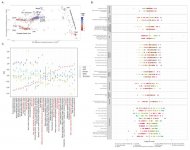real expert
Regular Member
- Messages
- 795
- Reaction score
- 455
- Points
- 63
Abstract
The Eurasian Holocene (beginning c. 12 thousand years ago) encompassed some of the most significant changes in human evolution, with far-reaching consequences for the dietary, physical and mental health of present-day populations. Using an imputed dataset of >1600 complete ancient genome sequences, and new computational methods for locating selection in time and space, we reconstructed the selection landscape of the transition from hunting and gathering, to farming and pastoralism across West Eurasia. We identify major selection signals related to metabolism, possibly associated with the dietary shift occurring in this period. We show that the selection on loci such as the FADS cluster, associated with fatty acid metabolism, and the lactase persistence locus, began earlier than previously thought. A substantial amount of selection is also found in the HLA region and other loci associated with immunity, possibly due to the increased exposure to pathogens during the Neolithic, which may explain the current high prevalence of auto-immune disease, such as psoriasis, due to genetic trade-offs. By using ancient populations to infer local ancestry tracks in hundreds of thousands of samples from the UK Biobank, we find strong genetic differentiation among ancient Europeans in loci associated with anthropometric traits and susceptibility to several diseases that contribute to present-day disease burden. These were previously thought to be caused by local selection, but in fact can be attributed to differential genetic contributions from various source populations that are ancestral to present-day Europeans. Thus, alleles associated with increased height seem to have increased in frequency following the Yamnaya migration into northwestern Europe around 5,000 years ago. Alleles associated with increased risk of some mood-related phenotypes are overrepresented in the farmer ancestry component entering Europe from Anatolia around 11,000 years ago, while western hunter-gatherers show a strikingly high contribution of alleles conferring risk of traits related to diabetes. Our results paint a picture of the combined contributions of migration and selection in shaping the phenotypic landscape of present-day Europeans that suggests a combination of ancient selection and migration, rather than recent local selection, is the primary driver of present-day phenotypic differences in Europe.
https://www.biorxiv.org/content/10.1101/2022.09.22.509027v1.article-info
The Eurasian Holocene (beginning c. 12 thousand years ago) encompassed some of the most significant changes in human evolution, with far-reaching consequences for the dietary, physical and mental health of present-day populations. Using an imputed dataset of >1600 complete ancient genome sequences, and new computational methods for locating selection in time and space, we reconstructed the selection landscape of the transition from hunting and gathering, to farming and pastoralism across West Eurasia. We identify major selection signals related to metabolism, possibly associated with the dietary shift occurring in this period. We show that the selection on loci such as the FADS cluster, associated with fatty acid metabolism, and the lactase persistence locus, began earlier than previously thought. A substantial amount of selection is also found in the HLA region and other loci associated with immunity, possibly due to the increased exposure to pathogens during the Neolithic, which may explain the current high prevalence of auto-immune disease, such as psoriasis, due to genetic trade-offs. By using ancient populations to infer local ancestry tracks in hundreds of thousands of samples from the UK Biobank, we find strong genetic differentiation among ancient Europeans in loci associated with anthropometric traits and susceptibility to several diseases that contribute to present-day disease burden. These were previously thought to be caused by local selection, but in fact can be attributed to differential genetic contributions from various source populations that are ancestral to present-day Europeans. Thus, alleles associated with increased height seem to have increased in frequency following the Yamnaya migration into northwestern Europe around 5,000 years ago. Alleles associated with increased risk of some mood-related phenotypes are overrepresented in the farmer ancestry component entering Europe from Anatolia around 11,000 years ago, while western hunter-gatherers show a strikingly high contribution of alleles conferring risk of traits related to diabetes. Our results paint a picture of the combined contributions of migration and selection in shaping the phenotypic landscape of present-day Europeans that suggests a combination of ancient selection and migration, rather than recent local selection, is the primary driver of present-day phenotypic differences in Europe.
https://www.biorxiv.org/content/10.1101/2022.09.22.509027v1.article-info


